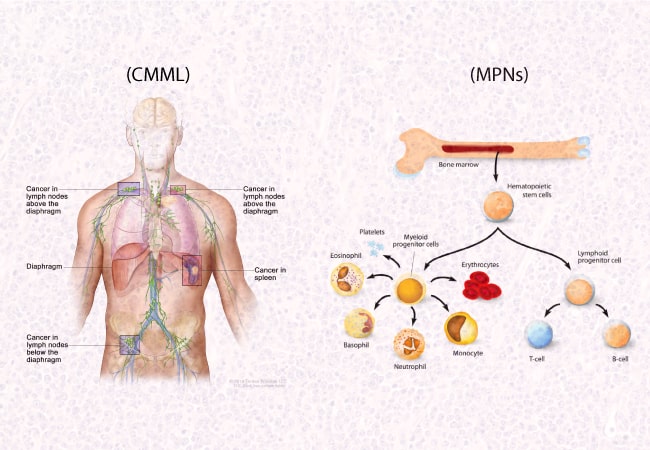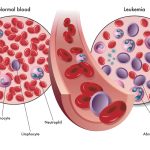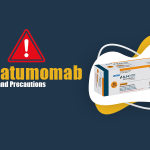Disease Overview:
Peripheral T-cell lymphoma (PTCL) isn’t just one illness. It’s a bunch of aggressive blood cancers that affect your lymph system and can spread to other parts of your body. They’re a type of non-Hodgkin lymphoma and can show up anywhere, causing lots of different symptoms. Doctors can treat most types, but they often come back. Researchers are working on new treatments to help people live longer with PTCL.
PTCLs are rare, affecting 2 in 100,000 people worldwide, and they make up about 10% of non-Hodgkin lymphoma cases. They’re more common in Asia, Africa, and the Caribbean, and mostly affect people over 60, although younger folks can get them too.
Types of Peripheral T-cell lymphoma (PTCL):
The World Health Organization (WHO) has identified over 20 subtypes of PTCL, each with its own unique genetic markers and features. As per one global study, the most common PTCL subtypes are:
Peripheral T-cell lymphoma, not otherwise specified (PTCL-NOS): It is the most common subtype of PTCL. It’s a bit of a catch-all category for cases that don’t fit neatly into other subtypes. About 30% of all PTCL cases fall into this group. PTCL-NOS mainly affects your lymph nodes, bone marrow, spleen, or liver.
- Angioimmunoblastic T-cell lymphoma (AITL): This is a specific type of PTCL, accounting for 15% to 30% of cases worldwide. It targets various parts of the body like lymph nodes, bone marrow, spleen, or liver.
- Anaplastic large cell lymphoma (ALCL): They come in various forms. One kind, primary cutaneous ALCL, shows up on your skin. Then there’s systemic ALCL, which affects your lymph nodes, skin, and other organs. Some cases of systemic ALCL are classified by changes in a gene called anaplastic lymphoma kinase (ALK). ALCL makes up about 15% of PTCLs, which are aggressive blood cancers.
- Extranodal natural killer/T-cell lymphoma, nasal type: This is a type of PTCL that usually starts in the tissues of your nose, sinuses, and upper throat. It can also spread to your skin, digestive system, and other organs. About 10% of PTCL cases are of this type.
- Intestinal T-cell lymphomas: They make up around 6% of PTCLs. These target your gut and include types like enteropathy-associated T-cell lymphoma (EATL) and monomorphic epitheliotropic intestinal T-cell lymphoma (MEITL).
- Adult T-cell lymphoma/leukemia: This can affect your skin and bones. There are four types: acute, lymphoma, chronic, and smoldering. The acute and lymphoma types grow fast and are aggressive. The chronic and smoldering types are less aggressive. Each type affects different parts of your body
Symptoms and Causes:
Each type of PTCL has its own symptoms, but some things that people might notice include:
- Swollen lymph nodes: You might notice painless lumps in your neck, armpits, or groin.
- Unexplained weight loss: Unexplained weight loss means you’re losing weight without trying. If you’ve lost 10% of your total body weight in six months without intending to, it’s a sign of unexplained weight loss.
- Belly (abdominal) pain or swelling: If your belly hurts or feels swollen, it might be because your spleen is getting bigger.
- Persistent fatigue: Persistent fatigue means feeling a lot more tired than usual for several days without any clear reason.
- Unexplained fever: Fever usually means your body’s fighting an infection. But if it stays above 103°F (39.5°C) for over two hours after home treatment or lasts more than two days, it could signal something serious.
- Specific subtypes if Peripheral T-cell lymphomas (PTCL) may have other signs and symptoms.
Causes of Peripheral T-cell lymphoma (PTCL):
Peripheral T-cell lymphomas happen when your T-cells, which usually fight off germs, start growing out of control and turn into cancer. They form tumors in your lymph nodes, spleen, liver, and other organs. Experts aren’t sure why T-cells mutate, but they think certain conditions might play a role. For example, having celiac disease might raise your chances of getting some types of PTCL. Also, getting infected with Epstein-Barr virus could increase your risk of another kind of PTCL. Similarly, having the human T-cell lymphotropic virus Type 1 (HTLV-1) might up your risk of acute T-cell lymphoma/leukemia.
Diagnosis and Tests:
To figure out which type of PTCL you have, doctors might do a bunch of tests like blood tests, scans, tissue samples, and genetic tests to study the genes of the cancer cells.
Blood Tests: Doctors might check your blood for viruses that are linked to peripheral T-cell lymphomas. They do this through blood tests, which can help spot any viruses connected to the condition. Blood tests may include:
- Complete blood count (CBC).
- Comprehensive metabolic panel (CMP).
- Lactate dehydrogenase (LDH) test.
- Hepatitis B and Hepatitis C tests.
- HTLV-Type 1 tests.
- Human immunodeficiency virus (HIV) test.
Imaging Tests: Imaging tests provide doctors with insights into what’s happening inside your body, such as identifying any tumors. These include:
- Computed tomography (CT) scan.
- Positron emission tomography (PET) scan
- Magnetic resonance imaging (MRI) scan
Biopsies:
- Lymph node biopsy.
- Skin biopsy.
- Bone marrow biopsy.
Treatment/Management of Peripheral T-cell lymphoma (PTCL):
Treating PTCL isn’t one-size-fits-all, and it depends on the type and stage of cancer. Doctors might use different treatments like chemotherapy, radiation, targeted therapy, or stem cell transplant. Common treatments may include:
- Chemotherapy: It combines different sorts of chemotherapy medicines.
- Radiation therapy: It may be used together with chemotherapy.
- Targeted therapy: It targets particular genetic changes or mutations that convert normal cells into malignant cells.
- Chemotherapy and Allo-SCT for treating PTCL that doesn’t respond to chemotherapy and radiation therapy or that returns following treatment.
Reference:
https://www.lls.org/lymphoma/non-hodgkin-lymphoma/nhl-subtypes/treatment-aggressive-nhl-subtypes
https://www.ncbi.nlm.nih.gov/books/NBK562301/#:~:text=Peripheral%20T%20cell%20lymphoma%20(PTCL,most%20frequent%20subtypes%20of%20PTCL.
https://lymphoma.org/understanding-lymphoma/aboutlymphoma/nhl/ptcl/#:~:text=Peripheral%20T%2Dcell%20lymphoma%20(PTCL,natural%20killer%20(NK)%20cells.






